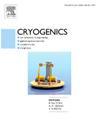微型斯特林制冷机蓄热器传热特性和有效性的数值评价:多部分计算研究
IF 1.8
3区 工程技术
Q3 PHYSICS, APPLIED
引用次数: 0
摘要
制冷能力从0.25 W到2 W,冷却温度在50 K到150 K之间的微型斯特林制冷机已经进入国防,航空航天和医疗行业。蓄热器是微型制冷机的重要组成部分,其性能对制冷机的运行有着重要的影响。本研究首先采用平行流动模型,数值分析了基体材料纵向热传导的非理想影响以及基体材料和工质的温度相关特性对蓄热器性能的影响。研究结果表明,非理想纵向传导可使效率相对提高137%,如果综合考虑基体材料和工质热物性的影响,效率可分别提高30%和5%。再生器的性能主要受纵向导电性和基体材料性能的影响。其次,利用cfd辅助方法对循环流动下再生器的二维多孔结构进行了模拟,研究表明,与恒定材料特性相比,温度相关特性的再生器的效率和温度波动分别高出298%和185%。此外,随着质量流量的增加,基体材料温度变化的影响不可忽略。最后,研究了冷尖热负荷的影响,发现冷尖热负荷对蓄热器温度分布及其效率有瞬时影响,从而影响蓄热器的高效传热能力。这种多部分的计算研究可以为改进高性能微型斯特林制冷机的蓄热器设计提供有用的分析和指导。本文章由计算机程序翻译,如有差异,请以英文原文为准。
Numerical evaluation of heat transfer characteristics and effectiveness of miniature Stirling cryocooler’s regenerator: A multi-part computational study
Miniature Stirling cryocoolers with refrigeration capacities from 0.25 W to 2 W and cooling temperatures between 50 K and 150 K have made their way to the defense, aerospace, and medical industries. The regenerator is an essential part and its performance has significant effects on the miniature cryocooler. In this study, firstly, the non-ideal effects of matrix material longitudinal heat conduction and temperature-dependent properties of both the matrix material and working fluid on regenerator performance are numerically analyzed using the parallel flow model. The findings show that non-ideal longitudinal conduction relatively increases in-efficiency by 137 % maximum, If combining the effects of the matrix material and the working fluid thermophysical properties, the in-efficiency will further increase by 30 % and 5 %, respectively. The regenerator’s performance is primarily affected by longitudinal conduction and matrix material properties. Secondly, the 2D porous structure of regenerator simulation under cyclic flow is performed using CFD-assisted methodology, and the studies show that compared to constant material properties, the in-efficiency and temperature swings of the regenerator for temperature-dependent properties are 298 % and 185 % higher, respectively. Additionally, the effect of matrix material temperature swing is found non-negligible with the mass flow rate increasing. Finally, the effect of the cold tip heat load is investigated and found that it has instantaneous effects on the regenerator temperature profile and its efficiency, thus influencing the regenerator’s capability to transfer heat efficiently. This multi-part computational study can offer useful analyses and guides to improve the regenerator design for high-performance micro Stirling cryocoolers.
求助全文
通过发布文献求助,成功后即可免费获取论文全文。
去求助
来源期刊

Cryogenics
物理-热力学
CiteScore
3.80
自引率
9.50%
发文量
0
审稿时长
2.1 months
期刊介绍:
Cryogenics is the world''s leading journal focusing on all aspects of cryoengineering and cryogenics. Papers published in Cryogenics cover a wide variety of subjects in low temperature engineering and research. Among the areas covered are:
- Applications of superconductivity: magnets, electronics, devices
- Superconductors and their properties
- Properties of materials: metals, alloys, composites, polymers, insulations
- New applications of cryogenic technology to processes, devices, machinery
- Refrigeration and liquefaction technology
- Thermodynamics
- Fluid properties and fluid mechanics
- Heat transfer
- Thermometry and measurement science
- Cryogenics in medicine
- Cryoelectronics
 求助内容:
求助内容: 应助结果提醒方式:
应助结果提醒方式:


